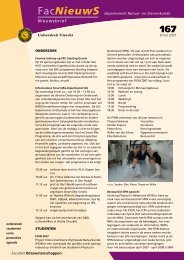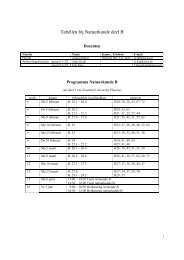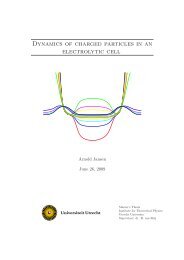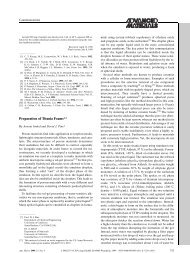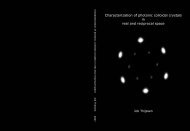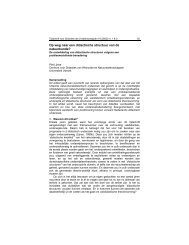Sedimentation Equilibrium of Mixtures of Charged Colloids
Sedimentation Equilibrium of Mixtures of Charged Colloids
Sedimentation Equilibrium of Mixtures of Charged Colloids
Create successful ePaper yourself
Turn your PDF publications into a flip-book with our unique Google optimized e-Paper software.
Appendix AArticleA.1 abstractWe theoretically study sedimentation-diffusion equilibrium <strong>of</strong> dilute binary,ternary, and polydisperse mixtures <strong>of</strong> colloidal particles with different buoyantmasses and/or charges. We focus on the low-salt regime, where theentropy <strong>of</strong> the screening ions drives spontaneous charge separation and theformation <strong>of</strong> an inhomogeneous macroscopic electric field. The resulting electricforce lifts the colloids against gravity, yielding highly nonbarometric andeven nonmonotonic colloidal density pr<strong>of</strong>iles. The most pr<strong>of</strong>ound effect is thephenomenon <strong>of</strong> segregation into layers <strong>of</strong> colloids with equal mass-per-charge,including the possibility that heavy colloidal species float onto lighter ones.A.2 Introduction<strong>Sedimentation</strong> in a suspension <strong>of</strong> colloidal particles is <strong>of</strong> pr<strong>of</strong>ound fundamentalimportance, and has been studied in detail for a long time. For instance,in 1910 Perrin determined the Boltzmann constant k B (and from this Avogadro’snumber) by comparing the measured equilibrium density pr<strong>of</strong>ile <strong>of</strong>a dilute suspension with the theoretically predicted barometric law [1], andmore recently the full hard-sphere equation <strong>of</strong> state was determined accuratelyfrom a single measurement <strong>of</strong> the sedimentation pr<strong>of</strong>ile <strong>of</strong> a densesuspension <strong>of</strong> colloidal hard spheres [2, 3]. In rather dilute suspensions <strong>of</strong>charged colloids, however, strong deviations from the barometric distributionhave recently been theoretically predicted [4, 5, 6, 7, 8, 9], experimentally observed[10, 11, 12, 13], and simulated [14], at least in the regime <strong>of</strong> extremelylow salinity. The most striking phenomenon is that the distribution <strong>of</strong> colloidsextends to much higher altitudes than is to be expected on the basis <strong>of</strong>53



